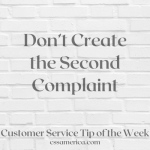The quality of the experience of a school student is based purely on their relationship with their teacher, right? The quality of the customer service at a hotel is based purely on their interaction with staff at the registration desk, correct? The season ticket holder’s perception of a sports club’s fan relations is based purely on their relationship with their sales representative, right?
I hope you didn’t agree with these statements, because so much about a customer’s perception of how they’re treated and valued is determined by people other than these key employees.
In the article New chief of Broward school buses: ‘We can fix things’, the new transportation director highlights one of her four key areas of focus being customer service improvements, particularly by training bus drivers. Now my company has actually trained bus drivers for a large school system as well, and there are reasons why this is done – whether drivers are with a student for 10 minutes one morning a week or for 45 minutes each way 5 times per week, a great deal of the student’s opinion (as well as their parents’ opinions) about their school experience can be impacted by these drives to/from school.
Granted, the experience in that classroom is hugely important, but many issues, relationships, discussions, delays, and general topics that require customer service skills occur on the bus.
The big point to take away is that we cannot assume that only one person impacts the customer’s opinion, and others are not relevant. We can’t assume that if an employee has a technical skill, then their communication and customer service skills are irrelevant.
Look at your organization through the customer’s eyes, and look at all of the touch points they have with individuals in positions not named “customer service” or “fan relations” or “reception.” See the impact that these others have on customer perceptions, and ensure they have the customer service skills to succeed.
Make students of your employees by teaching them customer service skills, techniques, and principles.
Learn about our CSS Education services at: http://cssamerica.com/cssed.htm
Interested in improving your educational organization’s customer satisfaction? See our other blog posts at: http://serviceadvice.cssamerica.com/category/education/





















